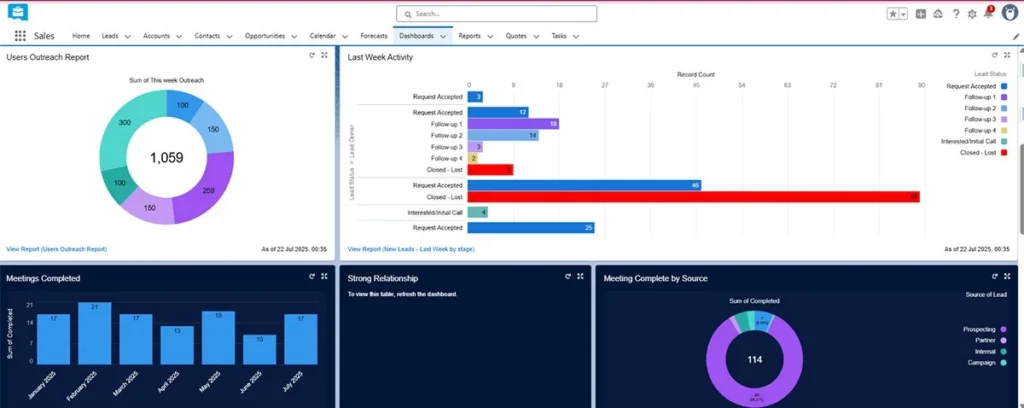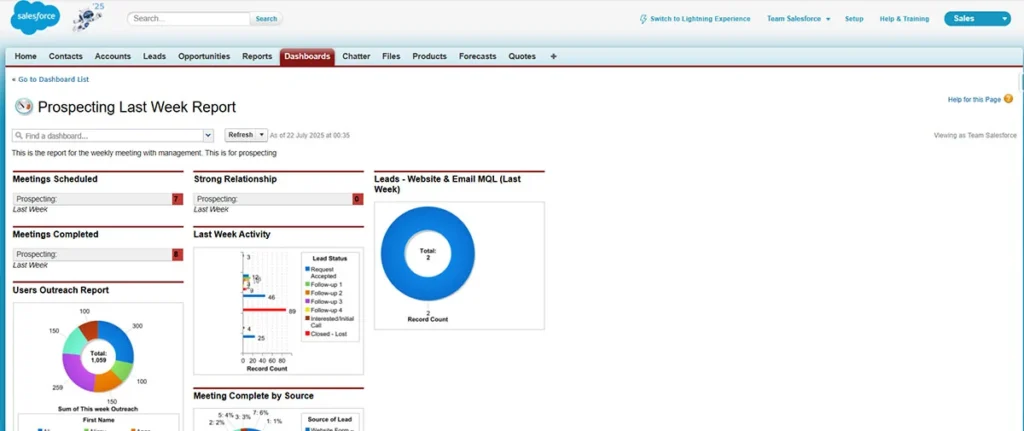
Salesforce has been a pioneer in the CRM market for years, offering solutions that help businesses of all sizes manage customer relationships, streamline operations, and gain valuable insights from data. However, one of the most frequently asked questions by new and existing customers is: Salesforce Lightning vs Classic – which one is better for organizations?
The Lightning experience ensures that you have immediate access to the latest Salesforce features as they become available, whereas Salesforce continues to support Classic, but no new features are being added to it since 2023, while all innovation now goes into Lightning
In this article, we’re going to look at the difference between Salesforce Lightning and Classic to help you figure out which one suits your business.
What is Salesforce Lightning?

For many years, Salesforce Classic was the trusted platform that helped businesses manage customers and grow. It served its purpose well, but the business world has changed. Today, speed, flexibility, and smarter tools are expected. This is where Salesforce Lightning steps in.
Lightning represents the future of CRM. It gives companies the power to make faster decisions, work together more effectively, and deliver stronger customer experiences. Choosing Lightning means preparing your business for the next chapter of digital growth.
Salesforce Lightning is the modern, component-based version of the platform. It delivers a more user-friendly Salesforce CRM interface and advanced options like custom branding and activity timelines. Lightning also gives users full access to Salesforce’s Einstein AI features, which makes it easy to automate workflows and strengthen the sales pipeline.
Salesforce Lightning is the newer version of Salesforce Classic, introduced in 2015. All new users start with Lightning by default, while existing users can switch to it without any extra charges. According to Salesforce, companies that moved to Lightning saw a 341% return on investment (ROI) within three years of implementation.
What is Salesforce Classic?

Salesforce Classic is the older version of the platform that businesses have used for many years. Its design is simple, similar to early web applications. While it covers the basic CRM functions, it doesn’t include many of the modern tools and enhancements available in Lightning.
Classic is still available mainly for long-time Salesforce users who prefer the older layout. However, new users are automatically set up on Lightning in Salesforce, with the option to switch to Classic from their user menu if needed.
Salesforce Lightning vs Classic: Key differences

If you’re deciding on Salesforce Lightning vs Classic, here are the main differences to help you choose the right fit.
1. User interface and experience
Classic: The layout is plain and text-heavy. It relies on tabs, which can make navigation slow.
Lightning: Has a modern, component-based design that looks simple and easy to use.
2. Performance
Classic: Slows down with large datasets and frequent page reloads, which can disrupt workflows. It’s fine for basic tasks, but it struggles with complex analysis.
Lightning: Uses modern web tech for quicker page loads and smoother navigation. It runs as a single-page app, reducing reloads. AI features and dashboards also improve speed.
3. Customization
Classic: Has limited customization. Changes often need Visualforce, Apex, or APIs, which can be time-consuming.
Lightning: Offers drag-and-drop customization with the Lightning App Builder and reusable components. Teams can create custom apps without coding.
4. Reporting and analytics
Classic: Offers basic reporting, limited interaction, and fewer advanced tools.
Lightning: Has tools like the Lightning Report Builder for interactive reports, real-time updates, and better insights.
5. AI integration
Classic: Doesn’t support advanced AI like Einstein. Most tasks still require manual input.
Lightning: Works seamlessly with Einstein AI, giving predictive insights and automating routine tasks.
6. Security
Classic: Basic security features, but less protection against modern threats.
Lightning: Stronger protocols like Locker Service, which keep components separate to block malicious input.
Making the decision: 5 key factors to consider
Before deciding, it’s important to review your business needs and long-term goals. Here are five things to keep in mind:
1. Current usage
If Classic already supports your workflows effectively, there may be no immediate need to switch. But if you’re considering Lightning, weigh the benefits against the time and resources required for migration.
2. Business goals
Think about both your short-term priorities and long-term vision. The platform you choose should align with your organization’s goals and objectives.
3. Customization needs
Ask yourself how much flexibility and personalization your team requires. Lightning offers more options, while Classic is more limited.
4. Integration compatibility
Check whether your existing third-party apps and integrations will work in Lightning. Most modern tools are supported, but some older ones may still depend on Classic.
5. Training and support
Switching to Lightning may mean extra training for your team. If you have the right consultant and proper support in place, it can smoother the transition and reduce productivity dips. Also, consider the level of ongoing support Salesforce provides for each platform.
Conclusion
Salesforce Classic gave businesses a strong base to start their CRM journey, but its time has passed. The focus of Salesforce is now on Lightning, which offers modern features that companies need to keep growing. It helps teams make better decisions, work together more effectively, and build stronger customer relationships.
Ready to move from Salesforce Classic to Lightning?
Xavor’s Salesforce experts can help you migrate seamlessly, customize your CRM to fit your needs, and unlock better performance with Lightning’s advanced features. Partner with Xavor today and transform the way your business uses Salesforce. Drop us a line at [email protected] to book your free consultation today.
FAQs
When will Salesforce Classic be retired?
Salesforce hasn’t announced an official retirement date for Classic yet. However, updates for Classic stopped in 2023, which means Lightning is the platform being prioritized for the future.
When was Salesforce Lightning released?
Salesforce Lightning was officially launched in 2015 as a modern upgrade to Classic, introducing a new interface, faster performance, and advanced features like drag-and-drop customization.
Is Salesforce Classic going away?
Salesforce hasn’t announced an official retirement date for Classic, but all new features are built for Lightning. Over time, Classic is expected to become less supported, making Lightning the long-term platform.
How to switch from Lightning to Classic?
Users can switch back to Classic by clicking on their profile icon in the upper-right corner and selecting “Switch to Salesforce Classic.
What is the difference between Salesforce Classic and Lightning?
Classic offers the core CRM functions in a simple, text-heavy interface, but lacks modern tools. On the other hand, Lightning delivers clean design, fast performance, advanced customization, and full access to AI features.
Salesforce hasn’t announced an official retirement date for Classic yet. However, updates for Classic stopped in 2023, which means Lightning is the platform being prioritized for the future.
Salesforce Lightning was officially launched in 2015 as a modern upgrade to Classic, introducing a new interface, faster performance, and advanced features like drag-and-drop customization.
Salesforce hasn’t announced an official retirement date for Classic, but all new features are built for Lightning. Over time, Classic is expected to become less supported, making Lightning the long-term platform.
Users can switch back to Classic by clicking on their profile icon in the upper-right corner and selecting “Switch to Salesforce Classic.
Classic offers the core CRM functions in a simple, text-heavy interface, but lacks modern tools. On the other hand, Lightning delivers clean design, fast performance, advanced customization, and full access to AI features.
